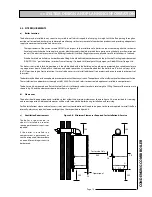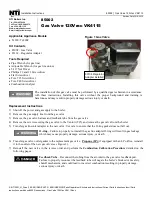
Page 18
4.0
SYSTEM DESIGN AND PLANNING INFOrMATION
4.3 DOMESTIc HOT WATEr cIrcuIT
a)
General
All domestic hot water (DHW) circuits, connections, fittings, etc. should be fully
in accordance with the relevant standards and water supply regulations. For
further information refer to:
In GB: Guidance G17 to G4 and recommendations R17 to R4 of the Water
Regulations Guide.
In IE: The current addition of I.S. 813.
When the domestic water system includes any device which prevents water
from expanding back towards the supply (e.g. check valves, loose jumpered
stopcock, water meter, water treatment device), then a mini expansion vessel
which has been approved for use in domestic water systems must be fitted
in the circuit (e.g. Zilmet 160ml, R1/ 15bar). If the hot water expansion is not
accommodated, then high pressure can develop in the circuit, which may
damage fittings and devices in that circuit (figure 4.7).
The maximum working pressure for the domestic hot water circuit of the boiler
is 8 bar, therefore all pipework, connections, fittings, etc. should be suitable for
pressures in excess of 8 bar. A pressure reducing valve (PRV) must be fitted
for pressures in excess of 8 bar or lower if any other components/fittings (e.g.
shower valves) require a lower working pressure. In practice it is recommended
that a PRV set to 3 bar is fitted for pressures above 5 bar. In general, ideal
pressure for these types of systems has been found to be between -3 bar.
b)
Terminal fittings
The boiler supplies mains pressure hot water therefore
all terminal fittings must be suitable for mains pressure
hot water.
It is recommended that flow regulators are fitted to
all taps/showers etc in line with flow rates set out in
Section 8.1 of the NHBC Standards BS 6700
If a shower is supplied from this appliance, then it
should be the thermostatic type suitable for use with
combi boilers.
c)
Hot water flow rates
The appliance is not fitted with a flow regulator. The
appliance will deliver hot water at a maximum flow
rate of 14.7 l/min at 35oC temperature rise. (This is
equivalent to 17. l/min at 30ºC temperature rise).
d)
Hard water areas
The Building Regulations L1A: New Dwellings/L1B:
Existing Dwellings and the requirements set out in
the Domestic Heating Compliance Guide specify that
“where the mains water hardness exceeds 00ppm
provision should be made to treat the feed water to
water heaters and the hot water circuit of combination
boilers to reduce the rate of accumulation of lime
scale”.
To comply with this requirement the hardness of the
mains water should be checked by the installer and if
necessary a suitable in-line scale inhibitor should be
fitted at a suitable point in the cold water supply to
the appliance.
If scale should ever become a problem the plate heat
exchanger is easily isolated and quickly replaced with
a service exchange unit which can be obtained at
nominal cost from Gledhill.
Figure 4.7
Other
Outlets
Expansion
Vessel
Check
Valve
Pressure Regulator
Stop Tap
To Hot Taps
GB35C
Boiler
Содержание GB35C
Страница 49: ...Page 49 CONDENSING COMBI BOILER ...
Страница 50: ...Page 50 ...
Страница 53: ...Page 53 CONDENSING COMBI BOILER ...
Страница 56: ......
















































